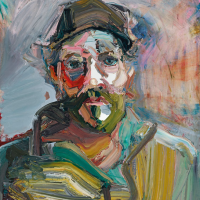85. BEN QUILTY

Portraiture is a fundamental component of Ben Quiltys artistic practice. Initially depicting himself and his friends as a means of exploring modern masculinity. In 2011 Quilty served as a war artist, and produced powerful, psychologically incisive portraits of Australian soldiers who served in Afghanistan, His aptitude for portraiture was recognised when he won Australias most prestigious portraiture award, The Archibald Prize, in 2011 for his painting of fellow artist and mentor, Margaret Olley (1923-2011).
Self-portraits are ubiquitous throughout Quiltys oeuvre. This is somewhat of a paradox for someone who does not often speak of himself, preferring to discuss the political and social issues that his paintings address. As writer Richard Flanagan describes, his paintings are about what he says they are about, but they are also about him, which frequently has nothing to do with anything he says. It is not that he is insincere. It is, I suspect, that he is unknown to himself.1 Quiltys raw, intimate self-portraits are an attempt to get to know himself, acting as a visual representation of his internal anxieties. The frequency with which he revisits the self-portrait format indicates that he has not yet been satisfied with his findings a metaphor for lifes continuous journey of self-discovery.
Self Portrait with a Hat 2021 was originally exhibited in Shape of an Image, a group exhibition at Woaw Gallery in Hong Kong in May 2021. The exhibition included artists from Spain, Germany, Iran, Belgium, Mexico, and the United State of America, with Quilty being the only Australian representative, highlighting the global appeal of his practice. The exhibition had a particular focus on artists seeking to transcend the traditional flatness of painting, incorporating three dimensionality into their canvases in the form of sculptural components, collage, or thick impasto paint surfaces a technique for which Quilty is best known. Self Portrait with a Hat is an interesting example this technique, as his face and body are composed of thick, viscous swathes of paint determinedly applied with a palette knife, while the background is relatively flat and murky. The thick paint then acts as an indication of the depth of the human condition in what is a comparatively insubstantial surrounding world.
The Encouragement Award No.2 2021 belongs to a body of work Quilty made through the COVID-19 lockdowns. During this time, Quilty was given a book on American realist painter, George Bellows (1882-1925), which sparked the series of paintings titled The Beach that were exhibited online at Tolarno Galleries.2 George Bellows was best known for his depictions of men boxing illegally in early twentieth century New York fight clubs. Despite his realist tendencies, these works are characterised by their visceral, dynamic figures with a keen sense of violent motion. The semi-abstract, tortured torso in The Encouragement Award No.2 is reminiscent of the twisted bodies and rough brushstrokes of Bellows 1909 painting Stag at Sharkey's, held in the collection of the Cleveland Museum of Art. In The Encouragement Award No.2 Quiltys characteristically textured paint is layered in shades of deep red and light purple, evocative of the pummelled flesh of the fighter. Lilac is Quiltys favourite colour, but as Lisa Slade so aptly describes, Quilty's lilac isn't quaint or even polite it's a bruise two days in.3
Where Bellows was inspired by boxing, the premier blood sport of his age, Quilty instead turned to newer spectacles of violence including Ultimate Fighting Championships (UFC) and the Cronulla Riots of 2005.4 Quilty revisited the haunting black and white images of the Cronulla Riots taken by photojournalist (and cousin), Andrew Quilty, which are held in the digital archives of the National Library of Australia. Quilty also referred to the UFC, an American mixed martial arts competition invented in the early 1990s. Taking place in an eight-sided enclosure officially named The Octagon, UFC has minimised the strict rules of most combat sports, allowing for unexpected and entertaining outcomes for its enormous global audience. Both the UFCs Octagon and the beaches of Cronulla are akin to Bellows boxing rings; spaces of conflict that are steeped in friction, violence, and a disconcerting masculinity.
In these settings, crowds play a fundamental role. The amorphous figures watching from the shadows in The Encouragement Award No.2 are emblematic of societys fascination with violence. Bellows and Quilty both focus on capturing the bloodthirsty mob mentality of a crowd when observing (and in many ways participating in) such carnage, relishing the flecks of blood and sweat flying towards them. Quilty is drawn to these demonstrations of violence, and peoples readiness to participate in them, as a reflection of the cultural disorientation of our contemporary society. Known for his social commentary, the dysfunction of our modern age is a familiar subject for Quilty, and one that has seen him become one of Australias most acclaimed and collected contemporary artists.
Footnotes:
1. Flanagan, R., Foreword, in Ben Quilty, The University of Queensland, Brisbane, 2009, p.18
2. Stojanovska, M., Ben Quilty: The Beach [online catalogue essay], Tolarno Galleries, Melbourne, 2021 (accessed October 2022: https://tolarnogalleries.com/artists/ben-quilty/
3. Slade, L., The Colour of Quilty, in Ben Quilty, The University of Queensland, Brisbane, 2009, p.27
4. Stojanovska, M., op. cit.
Asta Cameron